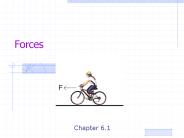Ch. 8 Forces - PowerPoint PPT Presentation
1 / 17
Title: Ch. 8 Forces
1
Ch. 8 Forces
2
Ch. 8 Sect. 1 Newtons 1st Law
- A force is a push or pull on an object. When one
object pushes or pulls another object, we say it
exerts a force on the other object. - Forces are described by how strong they are AND
in what direction. - Examples of forces
- Pushing a lawn mower, Lifting a book, Throwing a
ball
3
Nature of Forces
- Net Force overall force on an object (the sum
of all the forces) - Unbalanced Forces forces that change an objects
motion - start moving (speed up), stop moving (slow down),
or change direction. - If the net force does NOT equal zero, then it is
unbalanced.
4
Nature of Forces (cont.)
- Balanced Forces forces that will not change an
objects motion - Equal forces acting on an object in opposite
directions result in a balanced force. - If the net force equals zero, then it is balanced.
5
Newtons First Law
- An object at rest will remain at rest, and an
object in motion will remain in motion with a
constant velocity unless acted on by an
unbalanced force. - This concept can be shortened into one word
- INERTIA!
6
Newtons 1st Law (cont.)
- Inertia
- the tendency of an object to resist change in
motion - Imagine riding in a car and stopping suddenly at
a red light. You continue moving forward in your
seat due to inertia. - Inertia depends on mass
- The greater an objects mass, the more inertia it
has.
7
Friction
- Friction is another type of force.
- Friction is the force that resists sliding
between 2 touching surfaces or through air or
water. - Friction SLOWS DOWN an objects motion.
- Friction depends on two factors
- The types of surfaces involved
- How hard the surfaces push together
8
Friction (cont.)
- There are 3 types of friction
- Static prevents objects from moving when a
force is applied. - Sliding due to the microscopic roughness of two
surfaces. - Rolling between the ground and a wheel and
allows the wheel to roll.
9
Ch. 8 Sect. 2 Newtons 2nd Law
- The net force on an object is equal to the
product of its acceleration and its mass. - In other words
- Force equals mass times acceleration
- F ma
- Unit of Force Newton (N)
- Named after Sir Isaac Newton
- 1N 1kg (mass) x 1m/s2 (acceleration)
10
Gravity
- Gravity is a type of force.
- All objects exert a gravitational force on their
environment, but the gravity we most often refer
to is that of the Earth. - The gravitational force of the Earth is what
keeps us grounded.
11
Gravity (cont.)
- The gravitational force is also called weight!
On earth, weight is equal to the mass of an
object times the force of gravity (9.8m/s2)! - Terminal velocity is reached when the force of
gravity is balanced with the force of air
resistance. - Size of air resistance depends on
- Shape of the object
- Speed of the object
12
Other Forces
- Centripetal force when in circular motion, the
force is always perpendicular to the motion! - Gravitron ride at the fair! In which direction
are you feeling the force?
13
Newtons 2nd Law Practice
- A 40kg wagon is being pulled by a boy. The force
the boy exerts on the wagon causes it to
accelerate at 2m/s2. What is the force exerted
on the wagon? - Fma
- F(40kg)(2m/s2)
- F80N
14
Newtons 2nd Law Practice
- A woman uses a 70N force to push a 35kg shopping
cart. What is the resulting acceleration? - Fma
- aF/m
- a(70N) / (35kg)
- a2m/s2
15
Newtons 2nd Law Practice
- A boy throws a ball by exerting a 10N force. The
ball accelerates at 10m/s2. What is the mass of
the ball? - Fma
- mF/a
- m(10N) / (10m/s2)
- m1kg
16
Ch. 8 Sect. 3 Newtons 3rd Law
- If one object exerts a force on another object,
then the second object exerts an equal and
opposite force on the first. - Every action has an equal and opposite
reaction. Action-reaction - The law of MOMENTUM!
17
Newtons 3rd Law (cont.)
- If you push on a wall with 250N of force, then
the wall pushes back with 250N of force. - Action reaction forces act on different objects
and - When the mass of one object is considerably
larger than the mass of another object, the
action-reaction force is not noticeable. - Air and water exert action-reaction forces with
objects such as hands or canoe paddles. - A rocket launches due to the equal but opposite
forces of the burning fuel.































